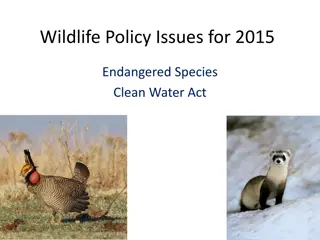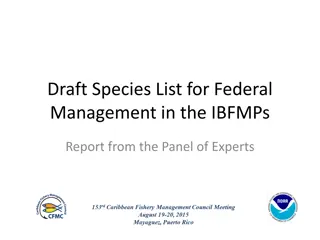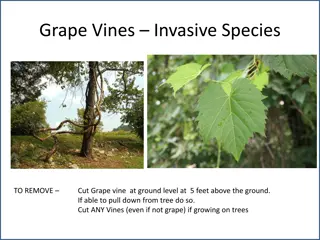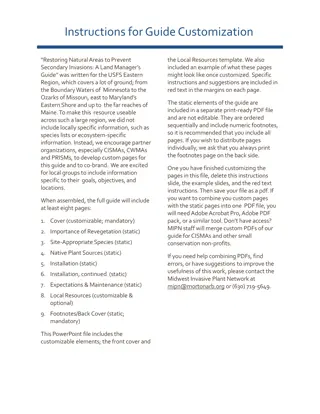Invasive Species Transmission Pathways
Explore the identification and transmission pathways of priority pests, focusing on the measures like plant pest analysis, survey enhancement, and rapid response capabilities for invasive species management. Delve into the critical role of human interactions in creating pathways for invasive species
2 views • 17 slides
Invasive Species in Northwest Michigan
Explore the impact of invasive species in Northwest Michigan through images and data on habitat support for butterfly and moth species, the transition of non-native plants to becoming native, and the definition of what makes a species invasive. Learn about the threats posed by non-native species and
4 views • 15 slides
Cladograms and Phylogenetic Analysis
Cladograms are used in cladistics to illustrate evolutionary relationships between organisms based on shared ancestral and derived characters. They are created by grouping species by common descent, forming clades that include an ancestral species and all its descendants. Valid clades are monophylet
0 views • 11 slides
Classification Keys for Identifying and Sorting Things
A classification key is a tool with questions and answers, resembling a flow chart, to identify or categorize things. It helps in unlocking the identification of objects or living things. Explore examples like the Liquorice Allsorts Challenge and Minibeast Classification Key. Also, learn how to crea
3 views • 6 slides
Basics of Fingerprinting Classification and Cataloguing
Fingerprint classification is crucial in establishing a protocol for search, filing, and comparison purposes. It provides an orderly method to transition from general to specific details. Explore the Henry Classification system and the NCIC Classification, and understand why classification is pivota
5 views • 18 slides
Biodiversity and Conservation: Importance and Key Concepts
Biodiversity is the variety of life on Earth, encompassing all species and ecosystems. Conservation efforts are crucial to preserve genetic, species, and ecological diversity. The values of biodiversity range from productive and economic to social and aesthetic. Maintaining a balance in ecosystems,
4 views • 17 slides
ROC Curves in Multiclass Classification
ROC curves are extended to multiclass classification to evaluate the performance of models in scenarios such as binary, multiclass, and multilabel classifications. Different metrics such as True Positive Rate (TPR), False Positive Rate (FPR), macro, weighted, and micro averages are used to analyze t
3 views • 8 slides
Field Guide to Native and Invasive Crab Species in Northern New England Intertidal Zone
This field guide provides detailed information on native and invasive crab species commonly found in the intertidal zone in northern New England. It includes identification features and distinctions among the species, serving as a useful tool for conducting intertidal green crab quadrat surveys. The
1 views • 4 slides
AI Projects at WIPO: Text Classification Innovations
WIPO is applying artificial intelligence to enhance text classification in international patent and trademark systems. The projects involve automatic text categorization in the International Patent Classification and Nice classification for trademarks using neural networks. Challenges such as the av
2 views • 10 slides
Impacts of Climate Change on Ecosystems and Biodiversity in the United States
Climate change is significantly affecting species, populations, and ecosystems in the United States. Changes include alterations in the characteristics of organisms, shifts in biological event timing, and disruptions in geographic ranges. These impacts can lead to extinctions when species can't adap
0 views • 16 slides
Taxonomy and Scientific Classification
Explore the world of taxonomy and scientific classification, from the discipline of classifying organisms to assigning scientific names using binomial nomenclature. Learn the importance of italicizing scientific names, distinguish between species, and understand Linnaeus's system of classification.
0 views • 19 slides
Managing Invasive Species to Safeguard our Forests
Invasive species pose a significant threat to the health of our nation's forests and grasslands, causing ecological, biological, and economic losses. This presentation highlights the impact of invasive species and underscores the importance of collaborative efforts to effectively combat this problem
2 views • 14 slides
Evolution of Division of Labor in Humans and Social Insects
Evolutionary advantages of cooperation and specialization led to a developed system of social cooperation and division of labor in humans and social insects. Despite vast differences, these species have conquered the earth due to common characteristics. The puzzle lies in why only a few species evol
2 views • 23 slides
Biosystematics and Its Significance in Biological Classification
Biosystematics plays a crucial role in refining biological classification by focusing on biological criteria to define relationships within closely related species. It helps delineate biotic communities, recognize different biosystematic categories, and understand evolutionary patterns. Through the
0 views • 15 slides
Overview of Fingerprint Classification and Cataloguing Methods
Explore the basics of fingerprint classification, including Henry Classification and NCIC Classification systems. Learn about the importance of classification in establishing protocols for searching and comparison. Discover the components of Henry Classification, such as primary, secondary, sub-seco
1 views • 21 slides
Caribbean Fishery Management Council Scientific and Statistical Committee Report 2012
The Scientific and Statistical Committee (SSC) of the Caribbean Fishery Management Council reviewed species units with Annual Catch Limits (ACL) overages and discussed research priorities. When ACLs are exceeded, accountability measures are triggered, leading to a reduction in the fishing season. Th
1 views • 26 slides
Various Species of Honey Bees in Apiculture
There are over 20,000 species of wild bees, with honey bees being important for commercial apiculture. Four significant species reared are Apis dorsata (Rock bee), Apis florea (Little bee), Apis indica (Indian bee), and Apis mellifera (European bee). Each species has unique characteristics and yield
0 views • 10 slides
Taxonomy and Classification in Biology
Scientists use classification to group organisms logically, making it easier to study life's diversity. Taxonomy assigns universally accepted names to organisms using binomial nomenclature. Carolus Linnaeus developed this system, organizing organisms into species, genus, family, order, class, phylum
0 views • 11 slides
The Impact of Invasive Species on Biodiversity and Ecosystems
The introduction of foreign species can have detrimental effects on biodiversity, ecosystems, and even humans. Invasive species like the Sea Lamprey and Burmese Python disrupt natural habitats, leading to a decline in biodiversity and posing risks to native species and human populations. However, th
0 views • 13 slides
Overview of Chestnut Species: American, European, Chinese, and Japanese Chestnuts
Important information about various chestnut species including American chestnut, European chestnut, Chinese chestnut, and Japanese chestnut is provided here. Details such as characteristics of leaves, twigs, buds, and growth patterns for each species are covered. Hybrid chestnuts and breeding effor
0 views • 16 slides
Wildlife Policy Issues for 2015: Endangered Species & Clean Water Act
Overview of policy issues surrounding endangered species and clean water act in 2015, including definitions, history, causes of endangerment, petition and listing factors. Focus on protecting species like the Lesser Prairie Chicken and Black-footed Ferret. Mention of Kansas' threatened and endangere
0 views • 21 slides
Helpful Functions for Iris Species Prediction and Dot Number Calculation
The provided content includes a function to predict Iris species based on petal length and width (Iris setosa, Iris versicolor, Iris virginica) and a function to calculate the number of dots in a figure pattern. The Iris prediction function uses specific criteria for each species, and the dot number
1 views • 6 slides
Draft Species List for Federal Management in IBFMPs Report
Panel of Experts was tasked with developing a draft list of species for federal management in Island-Based Fishery Management Plans (IBFMPs). Approaches outlined for selecting species include considering factors like species occurrence in State waters, stock status, ecological importance, and econom
0 views • 27 slides
The Impact of Invasive Species in Wilderness Management
Invasive species pose a significant threat to the ecosystem by causing disruptions in biodiversity and ecosystem health. This article discusses the importance of managing invasive species in wilderness areas and provides insights into creating successful Invasive Species Plans. It sheds light on the
0 views • 22 slides
Global Efforts in Managing Invasive Alien Species
Status reports on invasive alien species worldwide, including findings on successful eradications, regulations in various countries, and outcomes of online forums discussing technical guidance for managing invasive species under the CBD. Efforts include the development of tools, guidance, regulation
0 views • 10 slides
Invasive Plant Species Removal Guide
Learn how to effectively remove invasive plant species such as grape vines, garlic mustard, Japanese barberry, honeysuckle, and multiflora rose with detailed instructions and images for each species. Take necessary steps to remove these invasive species to protect native plant biodiversity.
0 views • 5 slides
Carolus Linnaeus - Father of Modern Botany and his Classification System
Carolus Linnaeus (1707-1778) is known as the Father of Modern Botany for his significant contributions to the field. He developed a systematic way of classifying species, introducing binomial nomenclature. Linnaeus published works like Systema Naturae and Species Plantarum, where he described and cl
0 views • 10 slides
Biological Classification and Candy Types
Explore the fascinating world of biological classification by learning about the scientific naming system of organisms. Discover the significance of genus and species names, and test your knowledge with fun candy-themed classification questions. From identifying Norn species to categorizing candy va
0 views • 22 slides
The Significance of Biodiversity in Ecosystems
Biodiversity plays a crucial role in boosting ecosystem productivity by ensuring each species contributes uniquely. Measuring biodiversity involves counting species in an area, with a higher species diversity indicating greater biodiversity. Despite this importance, an alarming number of species go
0 views • 17 slides
Island Biogeography Hypothesis and Species-Area Curves Overview
Explore the Island Biogeography Hypothesis through Shannon calculations and Species-Area Curve observed relationships. Learn about the mechanisms of island biodiversity, generalizations of species richness, and equilibrium concepts. Discover how area size influences species diversity and the impact
0 views • 24 slides
Hammerhead Worms: Invasive Species Identification and Overview
Invasive terrestrial flatworms known as Hammerhead Worms, including species like Bipalium spp. and Diversibipalium multilineatum, have been introduced to various regions, likely through soil or potted plants. Five invasive species have been identified, each with distinct characteristics and sizes. W
0 views • 9 slides
Hierarchical Semi-Supervised Classification with Incomplete Class Hierarchies
This research explores the challenges and solutions in semi-supervised entity classification within incomplete class hierarchies. It addresses issues related to food, animals, vegetables, mammals, reptiles, and fruits, presenting an optimized divide-and-conquer strategy. The goal is to achieve semi-
1 views • 18 slides
Criteria for Species Inclusion in Fishery Management Plans
The report outlines criteria for species inclusion in island-based fishery management plans, covering national standards, stock management, and minimizing costs. It discusses key factors such as target stocks, ecosystem components, and economic importance. The suggested draft criteria include biolog
0 views • 17 slides
Evolution and Species Classification
Explore key concepts such as microevolution, macroevolution, species definition, population genetics, and the development of new species through variation over time. Learn about the importance of isolation in species formation, the hierarchical classification system, and the six kingdoms of life.
0 views • 24 slides
Northwest Michigan Invasive Species Network Overview
The Northwest Michigan Invasive Species Network (ISN) is a Cooperative Invasive Species Management Area dedicated to managing invasive species in northwest Michigan's natural areas. Founded in 2005 and funded through grants and private donations, ISN collaborates with over 60 partners to address inv
0 views • 5 slides
Classification in Data Mining
Classification in data mining involves assigning objects to predefined classes based on a training dataset with known class memberships. It is a supervised learning task where a model is learned to map attribute sets to class labels for accurate classification of unseen data. The process involves tr
0 views • 26 slides
Biodiversity: Importance and Implications
Biodiversity encompasses the variety of plant and animal life on Earth, including genetic, species, and ecosystem diversity. It plays a crucial role in maintaining ecological balance and ecosystem processes. Traits and interactions among species influence ecosystem function, emphasizing the signific
0 views • 14 slides
Effect of Time of Day on Bird Species Richness and Individuals
The study investigates how the time of day impacts the species richness and number of individuals of birds at a specific feeder in Longwood University's Environmental Education Center. Through observational studies and counting, the researchers aim to determine if there are differences in bird popul
0 views • 20 slides
Rare & Endangered Species Trust: Protecting Namibia's Vultures and Pangolins
Rare & Endangered Species Trust in Namibia focuses on studying and supporting rare and endangered species, particularly vultures and pangolins. With a mission to find solutions to conservation challenges and maintain biodiversity, the trust highlights the history, crisis, and future prospects for th
0 views • 19 slides
Robust High-Dimensional Classification Approaches for Limited Data Challenges
In the realm of high-dimensional classification with scarce positive examples, challenges like imbalanced data distribution and limited data availability can hinder traditional classification methods. This study explores innovative strategies such as robust covariances and smoothed kernel distributi
0 views • 10 slides







































